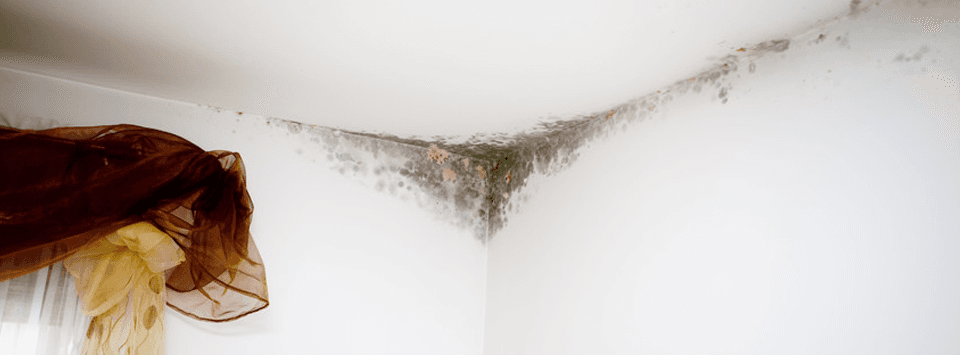
Mold: Nature's Garbage Disposal
There are thousands of different fungi (molds) in our environment. They exist as nature's garbage disposal and eat anything organic under the right conditions (the presence of moisture primarily).
In nature, mold feasts on fallen trees (wood rot is caused by mold), leaves, dirt, etc. And, unfortunately, in your home or business, mold doesn't know the difference between a fallen tree and wood studs or damp wallboard. Given the right conditions of moisture and a food source, mold will grow almost anywhere in your home.
How does mold get there? Mainly through the air as the spores are microscopic and will go airborne at the slightest disturbance. Every time you open a door or a window, mold spores waft into your home. Mold spores are everywhere: in every home, in every business.
What we and other mold professionals look for in an indoor environment is an amplification of particular mold types. Quite simply, if there are significantly more mold spores in your home than right outside your front door (a professional will test this for you), you may have a problem. Please note that it is not appropriate for a technician to just run an air test inside of a structure as some mold spores will show up almost every time, indicating a problem when there may not be one.
For additional information or to schedule a FREE inspection, please contact Mid-Atlantic Mold & Restoration
today.
Hot Spots For Mold
Crawlspaces And Damp Basements
Crawlspaces in this area are fraught with moisture problems caused by high water tables, poor drainage of rainwater, insufficient grading away from the home, condensation from HVAC ductwork and pipes, and excess humidity. The problem is that this moisture will lead to mold growth and/or insect (termites) or vermin infestations if left unchecked. Since the air in your crawlspace reaches your living space every day (up to 50% of the air on the first floor comes from the crawlspace), mold spores and any mycotoxins will invade your home as well. See our section on “crawlspaces” for more information.Musty, mildew odors are a sure signal that a basement is too moist. Look for patches of mold-like growths on the walls, ceiling, and floor. Also, mold is commonly found on cardboard boxes, wallboard, behind walls, and on wood studs (see our section on “basements”).
Kitchens And Bathrooms
In the kitchen, look behind or under the sink, above the stove, around the venting system, behind the cabinets, inside the cabinets, and below or behind the dishwashers. Slow leaks are the worst in that they are sometimes not found for days or weeks, and mold will almost certainly be established. Dishwashers are hot spots, not only for the possibility of leaks but for the “steam” they create, which easily condenses on the ceiling or cabinets. Make sure your exhaust vents are working properly over the stove and that they are not venting into the attic!
Bathrooms are obvious problem spots by their very nature. Look for leaks under the sink, around the toilet, and in the shower and bathtub. It’s not uncommon to find bathroom water invading lower level areas causing multiple mold problems on the ceiling, in the rafters, behind the walls, etc.
We have seen problems caused by consistent shower splash, either from curtains or improperly installed or closed doors. Just a little water added every day to the same area will often be “wicked” into surrounding porous material such as wood and wallboard causing major problems over time. Just as in the kitchen, make sure that your vent system is working to exhaust the steamy air, and make sure it’s not venting into the attic.
Attics
The problem we normally find with attics is poor ventilation stemming from improper design or non-working or occluded vents. Poor ventilation means that the humidity rising from your home or from the environment does not escape and will condense when the attic cools off in the evening. Condensation will also occur on un-insulated pipes or HVAC ductwork. Of course, as pointed out in the prior two sections, having bathroom, kitchen, or dryer vents exhausting into the attic is problematic.
Washrooms
Over the years, almost all of us are going to experience water problems or flood stemming from the washing machine. Sometimes, the automatic turn off fails when the machine is filling and the high-pressure water hose in the back of the machine bursts. Often, the drain hose starts to leak or slips out of the drain pipe. Just as in other areas, it is the slow leaks that you don’t discover for a while that cause the most mold damage. Some of the most toxic of molds thrive in very wet conditions and take up to a week to propagate.
Clothes dryers can also cause moisture problems when not vented properly. Dryer vents should exhaust to the outside of your home, not into the attic or another room. Also, clogged dryer vents will cause your unit to not function properly and will increase the humidity in your home. This also is a fire hazard, so please check your dryer vents frequently.
Renovated Rooms
There are countless horror stories of water or waste pipes being hit with nails or screws by an unsuspecting do-it-yourselfer or professional alike. Perhaps the worst is when just a “pinhole” leak is caused. There have been famous cases where a pinhole leak behind a wall went undiscovered for months and the extensive mold growth caused major and very expensive remediation work to be done. So, please be careful when piercing a wall with sharp instruments, whether you’re remodeling or just hanging a picture!
For Your Safety
If you think you have found mold...
- Try not to disturb it in such a way as to make the mold spores go airborne.
- Since #1 above is very difficult to accomplish, please put on a mask that has a filter rated to 3 microns.
- Do not touch the mold with your bare hands.
- Don't let the spores get into your eyes.

Mold Myths
Mold Myth #1: The myth we hear the most is that bleach is the best thing to use to kill mold
Here are the facts:
- Most of the time, mold is growing on a porous surface: wood, paper, drywall, paint, grout, etc.
- Bleach will only adequately dispose of mold on a non-porous surface! Why? The chlorine in bleach does not adequately soak into the wood, grout, etc. to kill the roots of the mold. What does soak in is the water in bleach, the primary ingredient, which ends up feeding the mold roots.
- For example, when you spray the typical over-the- counter chlorine solution on shower tile, what happens every time? The tile and grout look great for a week or two, then the mold starts to show again on the grout. The roots were not killed, and the mold grew back.
Mold Myth # 2: Mold killed by fogging or ultra-violet light is no longer a risk to my family
Here are the facts:
- Allergic reactions to mold are caused by the chemical compound on the surface of the mold spore.
- Even though a spore is "dead," the coating will still cause allergic reactions such as coughing, sneezing, itchy eyes, sore throat, etc.
- "Toxic Mold" which is killed but not removed, can still contain the toxins which are harmful to people and pets.
- It is not good enough just to kill the mold. It must be removed or encapsulated.

Our Promise To You
Safety
Mid-Atlantic Mold & Restoration's top priority. We meet or exceed all OSHA and EPA guidelines.
Competitive Pricing
We're efficient and do a high volume of jobs which makes our pricing more affordable than our competitors.
Timeliness
We will provide a free inspection generally within 24 hours and complete the job on time.
Minimal Disturbance
We will make every effort to avoid interruption of business activities.
Discretion
We maintain a low profile during the job to help safeguard your privacy.
Professionalism
Our team takes great pride in doing every job right and on time.
Mid-Atlantic Mold & Restoration's top priority. We meet or exceed all OSHA and EPA guidelines.
Competitive Pricing
We're efficient and do a high volume of jobs which makes our pricing more affordable than our competitors.
Timeliness
We will provide a free inspection generally within 24 hours and complete the job on time.
Minimal Disturbance
We will make every effort to avoid interruption of business activities.
Discretion
We maintain a low profile during the job to help safeguard your privacy.
Professionalism
Our team takes great pride in doing every job right and on time.
Call 240-577-2158 For A FREE Inspection!
Services Are Backed By A
1-YEAR Guarantee
Crawl Space Repair Is Available
Locally And Family Owned With Over 10 Years Of Experience



